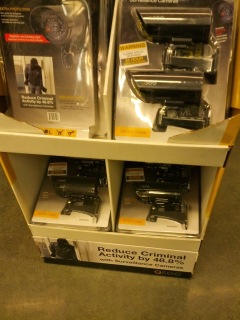
I can’t even begin to tell you how many times I run into stores that have decoy cameras in lieu of real cameras. I also can’t tell you how many countless times these same stores get robbed. Buying a decoy camera, in my opinion, are invitations for criminals. This is not to say most criminals can’t tell the difference between fake and real. This is to say that many of these businesses and homes that utilize decoy cameras don’t quite get what kind of mitigators they need to adequately protect themselves and their assets.
The added statistic at the bottom of this photograph is especially troubling because it dupes customers into believing they have added another layer of “security”. This is correct in some respects. Remember what I said about “security” being a goal and less of an action? The problem lies in exactly the same place issues of semantics in security are – it relies on data that is either incomplete and more than likely, irrelevant to their protection needs.
We all know cameras serve a variety of purposes other than video surveillance. We also understand some vendors and property owners either have poor tools or are so under-trained they may as well not have a camera. However, when an incident happens, the last thing property owners want to tell the police and insurance companies (worse yet, a jury in a civil liability trial) is they thought a decoy or non-operative camera offered better protection.
If you’re a property owner and considering one of these decoys, turn around and invest in a camera system you will monitor and maintain. If you’re a pro, call these out and the dangers behind using them.
Filed under: Crime Mitigation, Security Management
![]()